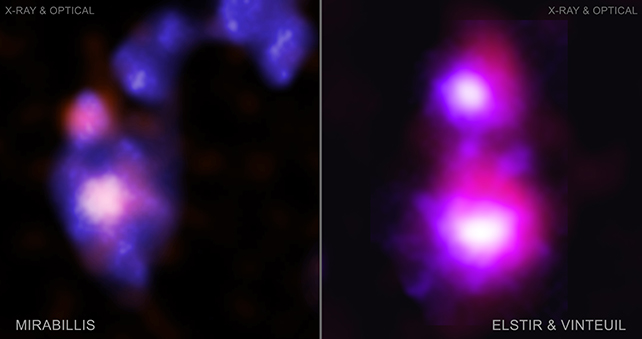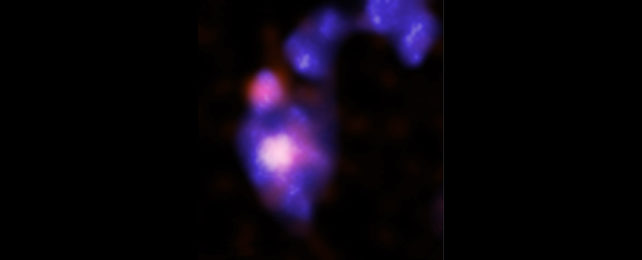For the first time, astronomers have spotted evidence of a pair of dwarf galaxies featuring giant black holes on a collision course with each other. In fact, they haven't just found just one pair – they've found two.
The first pair of merging dwarf galaxies is in the cluster Abell 133, about 760 million light-years away from Earth, and the other is in the Abell 1758S galaxy cluster, which is about 3.2 billion light-years away.
It's hoped that these sightings and further investigations will unlock some of the secrets of the very early Universe – a time when these colliding pairs of dwarf galaxies with black holes were a lot more common.

"Astronomers have found many examples of black holes on collision courses in large galaxies that are relatively close by, but searches for them in dwarf galaxies are much more challenging and until now had failed," says University of Alabama astrophysicist Marko Micic, who led the study.
What makes these observations challenging is that the smaller sizes of these galaxy pairs means their fainter light signatures are harder to see. These galaxies contain stars with a total mass less than about 3 billion times that of the Sun – whereas our own Milky Way holds the equivalent of about 60 billion Suns.
To make the discovery, the researchers combined data from multiple telescopes: X-ray results from Chandra, infrared results from WISE, and optical results from the Canada-France-Hawaii Telescope. It was the X-ray data that was crucial, which picked up on the larger signals being given off by the black hole pairs.
It appears that the Abell 133 merger is much further along – so much so that it only has one nickname, Mirabilis. That's after the endangered species of hummingbird known for its very long tail, in reference to the long tail observed around this pair of galaxies, caused by the collision.
As for Abell 1758S, the dwarf galaxies aren't joined up to the same extent, and get two nicknames: Elstir and Vinteuil (after artists in Proust's In Search of Lost Time). It appears that these galaxies and their black holes are currently linked by a bridge of stars and gas, and haven't merged to the same extent.
"Using these systems as analogs for ones in the early Universe, we can drill down into questions about the first galaxies, their black holes, and star formation the collisions caused," says astrophysicist Olivia Holmes, from the University of Alabama.
Over billions of years, these smaller, colliding galaxies are thought to have combined into the larger galaxies (including the Milky Way) that dominate the Universe now. The researchers describe them as our "galactic ancestors".
We might even be able to get clues about how our own galaxy came into being and evolved to the stage that it's at today. There are various inconsistencies about our home galaxy that still need resolving.
Now that astronomers have eyes on these dual active galactic nuclei (DAGN), they'll be able to verify that this is indeed what they are and collect further details on them, as our telescope and image analysis tech continues to improve.
"Follow-up observations of these two systems will allow us to study processes that are crucial for understanding galaxies and their black holes as infants," says astrophysicist Jimmy Irwin, from the University of Alabama.
The research has been accepted for publication in The Astrophysical Journal and is available to read on the preprint server arXiv.
